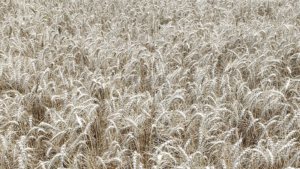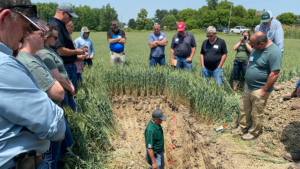Field Observations
FALL 2023

December 7, 2023
Another season has come and (mostly) gone. Corn harvest is roughly 90 to 100 per cent complete, and with another few good days of harvest, it should be nearing the finish line. Now is the time to order seed for next year’s crop. Provincial trial data is now available for corn and soybeans.
Corn
With less than a month until Christmas, many are hoping to wrap up harvest as bin space and weather allow.
Some tillage is being done as the weather allows. Remember that compaction is still a threat when moving on and working wet ground. Grain Farmers of Ontario Soil Compaction Fact Sheet shares some ways to help mitigate compaction.
The 2023 Ontario Corn Committee hybrid corn performance trial results have been released, and include more information on how to best utilize and interpret the data.
If you would like a full synopsis of the 2023 cropping year for all crops represented by Grain Farmers of Ontario, read A year in review in the December edition of the Ontario Grain Farmer Magazine.
This harvest season has had numerous ups and downs. For several, it is still ongoing, and some have had to deal with the challenges of DON, high moisture corn, lower test weights and delayed harvest in regions across the province. There are many support resources available should you need to speak with someone.
Soybeans
The Ontario Soybean and Canola Committee has now posted all provincial trial data and head-to-head data.
For suggestions on what to look for when choosing seed, Grain Farmers of Ontario has a Choosing the Right Seed Fact Sheet.
Cereals
It was a good year for cereal crop yields in 2023. Winter wheat and spring cereals yield can be found on Field Crop News.
November 30, 2023
Standing corn fields now have a blanket of snow in most cases, hindering harvest again. For this time of year, there still seems to be a lot of corn to harvest, but the acres to be harvested are dwindling.
Corn
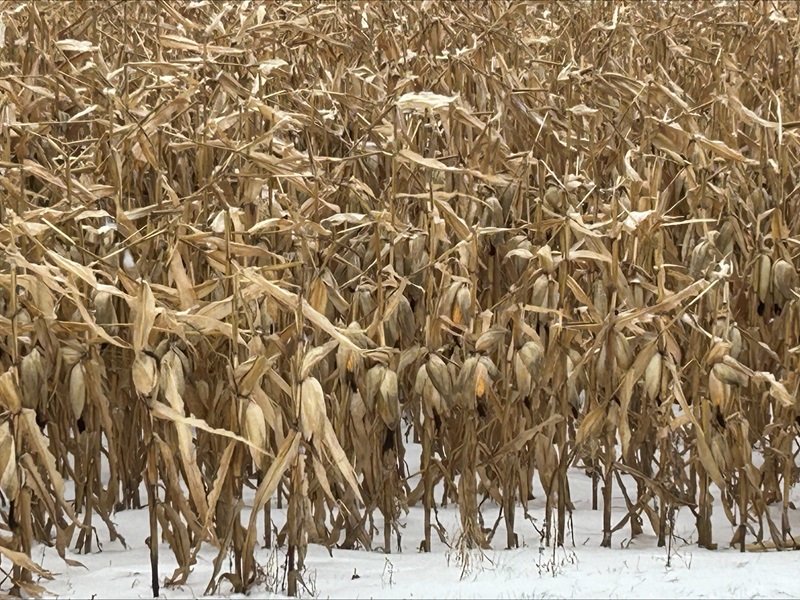
Corn harvest continues, with approximately 80 to 100 percent of acres harvested province-wide. With heavy snow moving into much of the region, harvest will again be at a standstill.
Reported moistures range between 20 to 35 percent with grades between 2 and 5 (lower grades due to test weight). Some are choosing to leave wetter corn standing and harvest it later in the year, hoping that the moisture will go down and the grade will go up.
If deoxynivalenol (DON) is a concern, the best practice is to get a DON test immediately, as the crop is harvested. This allows the chance to segregate higher DON corn. Also to be considered is that corn should be dried ASAP to limit the increase of the DON toxin, which can keep accumulating in wet corn. Corn that is harvested and left in a wet bin to be dried later can see a significant increase in DON in some cases.
The Ontario Corn Committee hybrid performance trials are published online at www.gocorn.net.
Soybeans
The Ontario Soybean and Canola Committee (OSACC) has posted provincial trial data for some areas, with more to be shared in the coming days.
November 23, 2023
The good stretch of open weather last week has allowed soybean harvest to wrap up and a large percentage of the province’s corn to be harvested. Some acres of corn remain, harvest moistures have been higher, and drying has been slow.
Corn
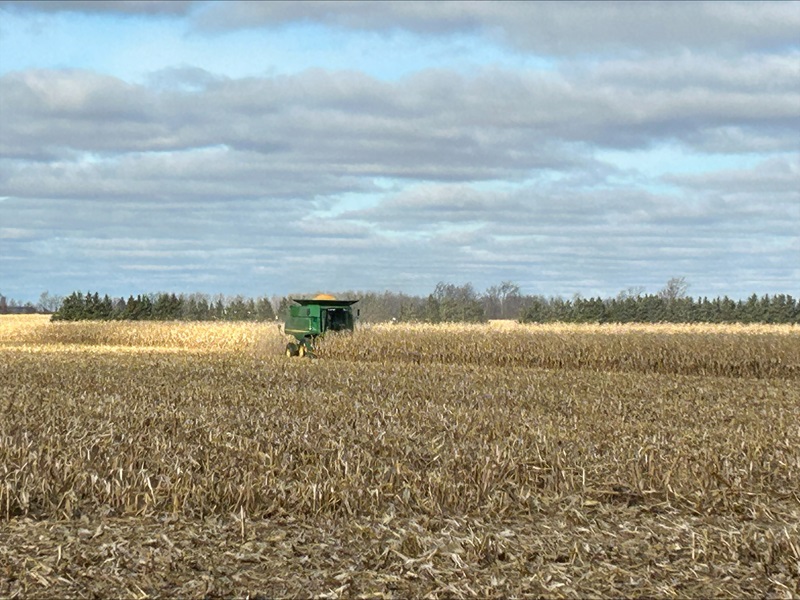
The last couple of weeks have allowed the bulk of the corn acres to be harvested – roughly 60 to 100 per cent complete across the province. Yields have been reported as average to good, with moisture being reported in the low 20s to well into the 30s.
Deoxynivalenol (DON) remains a challenge for farmers as the fall harvest continues. The 2023 DON survey, a joint effort between the Ontario Ministry of Agriculture, Food and Rural Affairs, Grain Farmers of Ontario, and Ontario Agri Business Association members that was conducted in early October, gave early indications of some elevated levels of DON in pockets across the province of this year’s corn crop.
However, note that the DON threat this year is elevated compared to the last four years but will NOT be as broad as 2018. It is also important to note that since the survey was released, a high volume of good-quality corn has been received at elevators across the province.
Grain Farmers of Ontario has several resources for farmer-members to use if they find DON in their corn at higher levels:
- information on research in DON testing and sampling
- an informational sheet on DON in corn
- Grain Farmers of Ontario Grain Contract Guide
- Code of Practice for trade in barley, canola, corn, oats, and wheat in Ontario (which includes guidance for dispute resolution)
There has been some discussion of leaving corn to stand in the field to allow for further drying down. If this is being done, ensure that there is still good stalk integrity. The Grain Farmers of Ontario Stalk Integrity Fact Sheet shares thresholds for when a field should be prioritized for harvest.
Some tillage has been taking place on corn stalks and some baling of corn stalks – remember to replace the nutrients removed when removing the stover.
Seed selection is here, and there are several items to keep in mind when selecting corn hybrids. Agronomic package – maturity, disease tolerance, match genetics to management and needs while considering test weight, dry down, husk cover, plant height, and pollination timing.
Right insect traits – choose the traits for field needs and field conditions; don’t use the wrong traits if there are insect resistance issues such as corn rootworm. Create an insect resistance plan to help mitigate resistance. Visit Field Crop News for more details.
End-use – know what the end user is looking for and accepting. Some traits may not be approved, specific quality parameters such as low DON levels, or a specific test weight that are required for delivery.
Remember, when choosing hybrids, don’t pick hybrids based on any one season or one location. Look at multiyear evaluations across different environments and compare them to known products. The Ontario Corn Committee (OCC) trial results will be published in the coming weeks. The trial data includes head-to-head comparisons of hybrids, which can be viewed using the Hybrid Comparison Selector on the website.
Remember to select a package of hybrids you are comfortable with, have experience with, and know how to manage. Growing a package of hybrids varies the risk by spreading out the pollination period and diversifies your investment.
For more information on seed selection, view the Grain Farmers of Ontario Choosing the Right Seed Fact Sheet.
Soybeans
2023 provincial soybean trial data from the Ontario Soybean and Canola Committee should be available on November 24. These trials are a great resource to see how varieties perform regionally.
Cereals
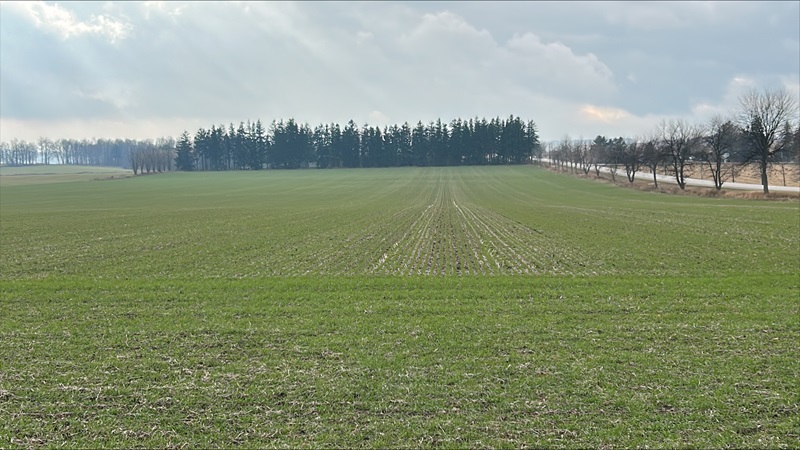
There were a few acres of wheat that went into the ground later than ideal this year due to weather hampering soybean harvest and winter wheat planting. A similar situation happened a few years ago, and there were questions about whether wheat will still be able to vernalize and produce grain if it has not emerged (without vernalization, winter wheat will not be able to produce seed; it will only remain in a vegetative state while growing). The answer is that winter wheat does not need to emerge for the vernalization process to occur; it only needs to germinate.
There has been adequate soil moisture across much of the province for winter wheat to germinate this fall (go out and take a look! There will be germinated seedlings under the soil), and therefore vernalization can occur. However, of course tillering will be lower (if not non-existent), as wheat does need to emerge to begin the tillering process and so yield potential will be impacted.
November 16, 2023
Dear combine/truck/grain cart driver: the world is a better place with you in it.
As harvest continues, corn moisture remains high, with some grain getting downgraded due to low test weights, depending on the location within the province. While some have had incredible yields, others have average yields. But all can agree that even when times get challenging, there is still so much that is good.
Corn
As the intro suggests, not all is fine and well in some areas. A cooler summer has led to lower crop heat unit (CHU) accumulation with some corn not black layering before a frost, resulting in lower test weights and higher moistures at harvest. Grades coming across the scale range from grade 2 to grade 4 (downgrading due to test weight). Corn harvest is roughly 50 to 80 percent complete, with moistures ranging from the low 20s to mid to high 30s.
Test weights can be impacted by environmental conditions interacting with genetics, including physical characteristics of the kernel, such as size, shape, and starch type. Management conditions such as planting date, harvest date, moisture at harvest, fertility, and disease protection also play a role. Plant stress, such as disease, insects, low soil fertility, and environmental conditions such as heat, cold, or drought, can also slow the corn factory down and reduce the amount of carbohydrates the plant produces. In some cases, the plant does not reach black layer before it is shut down from frost or disease.
This past week and looking forward look like close to ideal harvest weather, with double-digit temperatures being welcome this time of the year, and with not much rain/snow in the forecast, it will allow those choosing to combine to do so. Some might aim to take the headlands off fields and hope the corn dries down a bit more in the coming days.
With high moistures and good yields in some areas, elevators are getting full of wet corn, limiting the ability of corn to come off the field. This might be the case for the foreseeable future as everyone scrambles with loads of corn that need more time in the dryer.
It might not be top of mind right now; however, with wet ground and more moisture in the forecast, planning to mitigate compaction should be considered. More can be found in the Grain Farmers of Ontario Soil Compaction Fact Sheet.
Soybeans
Soybean harvest is mostly wrapped up across the province. A few acres remain in central, eastern, and the Niagara region, and they will be harvested as weather and bin space allow.
When choosing soybean varieties for next year, be aware of what varieties have done well on each farm and in the area, and remember to look at multi-year trials, not just one season. If white mould is a concern, variety selection of less susceptible varieties for white mould is a good first step with the added agronomy practises of lower population and wider row spacing to help keep the canopy dryer during pollination. The Ontario Soybean and Canola Council (OSACC) trials will be released later next week and are a great source of information for how varieties do regionally.
The Grain Farmers of Ontario Choosing the Right Seed Fact Sheet has some helpful hints as seed selection season begins. Remember that early order and early pay discounts from seed suppliers are approaching quickly; take advantage of these if possible.
Cereals
The Ontario Cereal Crop Committee has now posted the 2024 Spring Cereal Report. The report covers trial data for spring-planted barley, oats and wheat. You can find it under the ‘Performance’ tab; it is also available as a PDF. Grain Farmers of Ontario is a voting member of the Ontario Cereal Crop Committee.
November 9, 2023
What had started out as a promising week for harvest has turned into another rainy, wet week, with some areas even receiving snow or freezing rain. The focus has turned solely to getting the crops off, but high moisture in corn and soybeans has impeded harvest. As harvest progresses, be sure to watch for large corn piles growing outside of elevators as everyone struggles to harvest, dry, and ship corn in a timely manner.
Corn
Black layer (physiological maturity) matters; some farmers are finding this out while harvesting corn well into the high 30 percent moisture range, if not 40. However, fields that did not reach black layer in some cases have pushed the boundaries for seed choice for the region, and in other cases, the crop heat unit (CHU) accumulation for that area was lower than average. Cool, cloudy, rainy days impacted CHU accumulation over the course of the season. Wet grain is concerning due to the cost of drying the corn, and the hauling of extra water has an impact on the return on investment. It is a calculated cost to either prevent accumulating DON levels by harvesting wetter corn or letting the corn dry in the field and risk increasing DON levels along with the risk of winter weather causing harvesting difficulties.

Others are reporting 22 to 32 per cent moisture and excellent yields. It is thought that roughly 10 to 25 percent of harvest is complete. With big yields in some areas and the weather not always cooperating, the harvest may indeed stretch well into the next month.
As harvest continues, watch the Grain Farmers of Ontario webinar on grain bin safety featuring Dean Anderson of Workplace Safety & Prevention Services (WSPS). Anderson includes some extremely valuable tips on bin safety and bin rescue. Everyone who handles grain should watch this webinar as a valuable addition or reminder to your knowledge.
Soybeans
On a recent drive to the eastern region of the province, it was seen that there are still several soybean fields not harvested. This week looks like a poorer forecast than originally thought with snow and freezing rain, but next week will hopefully allow those final acres to be harvested. A few dry days in southwestern Ontario this week have seen some more bean fields harvested. Slowly but surely, these soybeans will be harvested, as acres completed reach the 80 to 90 percent mark.
November 2, 2023
A cold, wet start to the week that brought snow to some regions has kept combines parked. Most areas are dealing with wet corn and soybeans that are still in the field due to weather delays causing a slow harvest. With any luck, a small window will open up in the coming days, allowing the soybean harvest to inch closer to the finish line and allow the corn harvest to pick up some steam.
Corn
There has been a small number of fields harvested so far this year. Most have been taken off as high moisture corn to feed livestock as grain bins were low. As the calendar has turned to November, larger farmers are seeing the need to start as the forecast from now on out gets colder with a higher chance of snow to hinder the harvest. Moisture for corn in the field is still in the high 20s to low 30s; ideal drying weather will be hard to come by from here on out.

The 2023 Ontario Grain Corn Ear Mould and Deoxynivalenol (DON) Mycotoxin Survey was released last week by the Ministry of Agriculture, Food and Rural Affairs (OMAFRA). The survey is a collaboration between OMAFRA, Grain Farmers of Ontario and Ontario Agri Business Association members. Grain Farmers of Ontario has published two fact sheets with more information on DON in general and testing for DON in corn.
Dealing with wet corn can cause its own issues (not to mention a higher drying bill). If wet grain is in grain buggies, gravity wagons, or combine hoppers, it can get “stuck,” making it less flowable the longer it sits and can cause a safety concern. Over the last number of years, there have been too many reports of someone entering areas with augers to persuade the grain to flow and get caught themselves. Please don’t become a statistic, make sure to work with a partner when trouble occurs and do not enter moving grain or grain that could start moving due to engaged augers, etc.
Of course, wet corn takes longer to dry than lower-moisture corn. Don’t increase the temperature when drying corn, thinking it will speed up drying as higher temperatures will increase the risk of dryer fires.
Make safety the first priority over the coming weeks.
Soybeans
With a few more days of positive-looking weather on the horizon, the soybean harvest will hopefully be close to wrapping up.
Remember that harvesting soybeans when the ground is saturated can cause conditions where soybeans can be mud-tagged. According to the Canadian Grain Commission, a soybean completely covered with caked mud is considered damaged.
Winter wheat
Winter wheat continues to grow. As temperatures drop, winter wheat begins to acclimate to the cold. Certain genes within wheat produce a substance that protects the cell membranes. In a wheat plant that has developed a minimum of four to five leaves and one to two tillers, cold acclimation begins when soil temperatures at the crown go below 10° C. If the plant is not at this stage, the lack of tillers heading into winter can result in an inadequate number of heads the following year, affecting yield. Tillers can still develop in the spring, but the yield potential may differ between tillers formed in the fall and spring.
It takes approximately four to six weeks with soil temperatures below 10° C at the crown depth for the wheat plant to fully harden. The colder the soil, the more quickly the plants develop winter hardiness. Fluctuating air temperatures experienced recently also influence soil temperature to a point. Once the cold acclimation begins in the fall, wheat plants can unharden when soil temperatures at the crown go above 10° C and re-harden when the soil at the crown goes below 10° C.
Most regions have now edged past the Agricorp deadline for fall seeding of winter wheat, with the deadline to report planted acres being November 8, 2023.
October 26, 2023
Heavy frosts across most of the province will result in any remaining green plants terminating (halting photosynthesis) if disease or maturity hasn’t already ended the crops’ life cycle. With that, corn harvest will pick up speed as drydown and weather allows in many areas. Soybean harvest is close to wrapping up and thanksgiving winter wheat is emerging.
Corn
Heavy frosts for some areas will effectively shut down the corn crop and might spur on some harvest. Average frosts for most of the southern portion of the province in the last week of September into the first or second week of October (for the deep southwest), as the first really hard frost has just been seen now, it has been a true blessing for winter wheat development and corn maturation.
There has been some select fields of corn harvested so far this year with moistures ranging from 25 to above 30 per cent moisture. For most areas, with black layered corn and fields with low disease pressure, good test weights will be seen. However, areas with corn that has not reached black layer will experience a lower test weight.
The 2023 Ontario Grain Corn Ear Mould and Deoxynivalenol (DON) Mycotoxin Survey was released earlier this week by OMAFRA. The survey is a collaboration between OMAFRA, Grain Farmers of Ontario and members of the Ontario Agri-Business Association.
Soybeans
Soybean harvest is getting closer to wrapping up, after another few days of positive weather allowed for combines to get rolling again. IP soybeans are causing harvest delays as they must be below a certain moisture for delivery, and with weather that has not been conducive to drying, IP soybean harvest is proving to be a challenge. With 75 to 100 percent complete, some areas are heaving a sigh of relief while others still struggle to get soybeans off the field with scattered rains. Overall, yields and quality have been average.
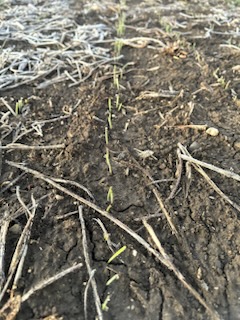
For Northern Ontario, there are still a few fields of soybeans out, they will be harvested as weather allows.
Cereals
Once all winter wheat seedlings have emerged, stand assessments can be done. It is a great time to assess planter performance as well as any issues that may need to be mitigated early in the spring. If a stand is uniform, it will be easier to time applications of herbicides and fungicides once wheat greens up and begins actively growing in the spring. However, now is not the time to decide whether to keep a stand or terminate it, that will be done in the spring after green up. With a few more warm days in the forecast, it will allow wheat to continue germinating, emerging and tillering.
October 19, 2023
It’s not Halloween yet, but cornfields in some regions are beginning to look a bit scary. Tar spot has killed plants, ear rots are showing up, and higher moisture corn might be a concern due to corn that has yet to reach black layer.
In other news, soybean harvest continues as weather allows, as does winter wheat planting. Find out where to get an Ontario-specific winter wheat staging guide and prepare to stage emerged wheat!
Corn
Corn has been lucky to have an extended fall season without much if any, heavy frosts to shut the plant down. Some fields have black layered, others are close to, and with the extended frost-free season, have really had a chance to sink starch into the kernels. However, if the plant should die and black layer has not been reached, it can affect test weight. If black layer is not reached before the plant shuts down, the moisture of the kernel could be high. Black layer indicates a rough moisture of 32 per cent and will decrease from there based on good drying days. Some corn not quite at black layer could lead to some wet corn at harvest.
Ear rots are beginning to show up in fields with conducive environments (high moisture environment, tight husks, etc). Some ear rots can be the cause of mycotoxins; thus, it is important to be able to identify which ear rots are being found in the field. Find out more about ear rot online. Harvest infected fields early and segregate the grain.
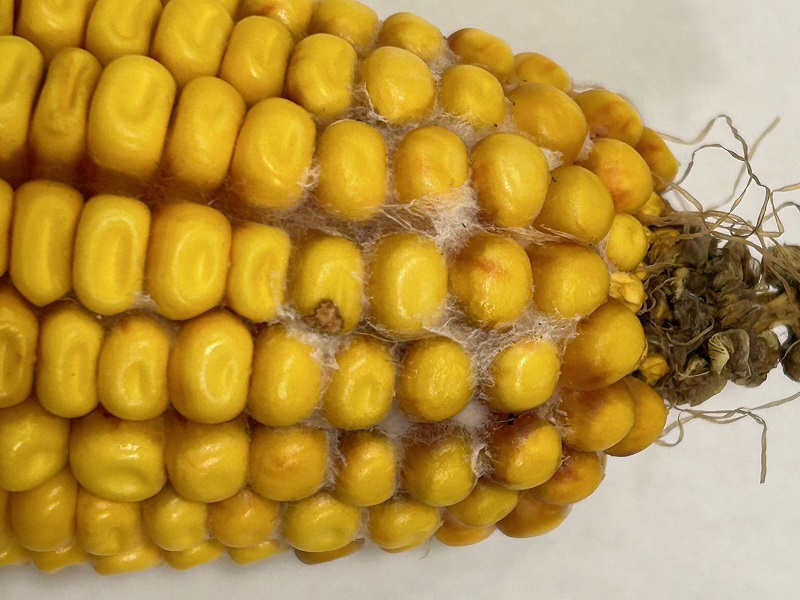
Crop heat (CHU) accumulation is all over the place across the province. CHUs in Elora show 30 CHU lower than the historical 53-year average. Ridgetown is 131 below the historical 11-year average. However, in eastern Ontario, Kemptville is 77 CHU over the 53-year average, with much of the above-average accumulation this fall. Dry down will be the key consideration for field harvest selection as fields will vary in moisture due to planting date, hybrid selection, hybrid maturity, field management, field stress, disease presence, and frost damage.
Seed selection time is drawing near; choosing the right seed is critical to starting the season off well. For more information, view the Grain Farmers of Ontario Choosing the right seed Fact Sheet.
Soybeans
The soybean harvest has remained stop-and-go this past week. However, it is close to wrapping up with 60 to 90 percent complete.
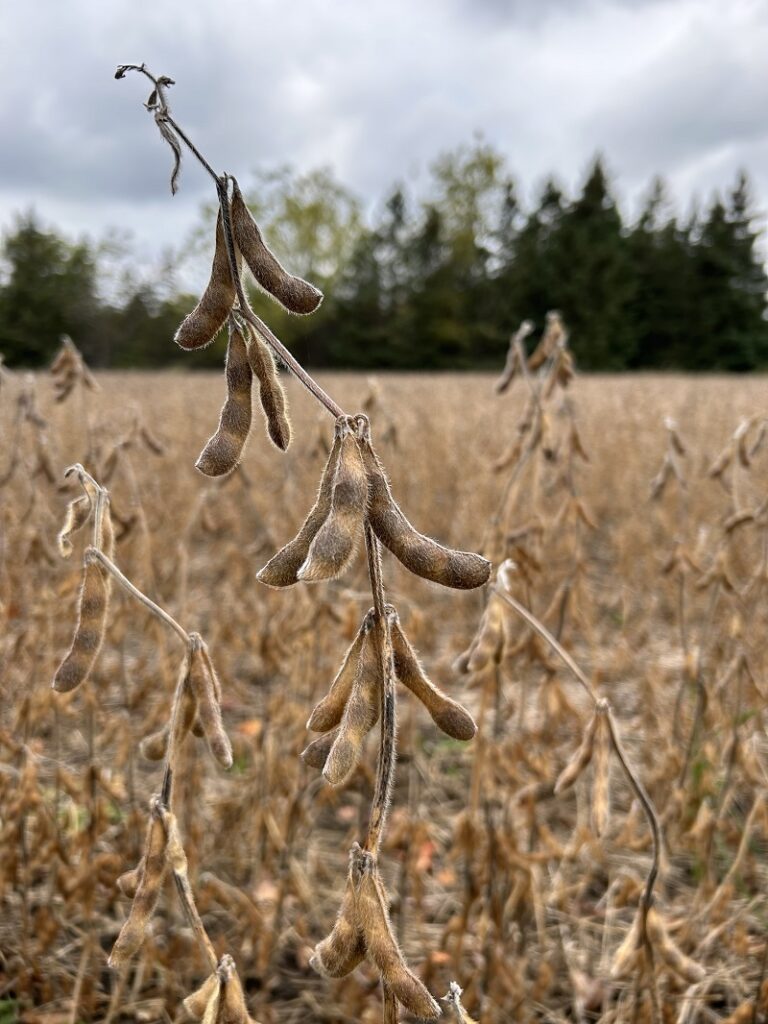
White mould is still causing some harvest woes, with decreased yields, in various regions. Aim to harvest white mould-infected fields last so as not to spread the sclerotia (looks like mouse droppings) to non-infected fields. Clean combines well after harvest, record fields that had the disease and manage fields accordingly in the future (crop rotation, tillage, more susceptible variety).
Planting soybeans after soybeans will increase the risk of white mould infection. With a fresh population of disease spores at the surface, this pathogen will be ready to sporulate next year if favourable environmental conditions develop. Rotation to another crop would be the best choice for reducing risk, but other agronomic practices, like creating an open canopy through wider rows or lower population, can help prevent those ideal dense canopies. Variety selection and fungicide selections will also need to be considered.
Cereals
Winter wheat continues to be planted as conditions allow.
A reminder that the Zadoks’ scale for wheat staging begins at zero for a dry seed and moves upwards 10 for seedling growth and 20 for tillering; only primary tillers are counted. For example, a seedling with two leaves unfolded would be GS12, and a plant with the main shoot and two tillers is GS22.
Understanding cereal staging is important for various applications of herbicides, fungicides, fertilizers, and plant growth regulators. Check out A Visual Guide to Winter Wheat Staging. It can be downloaded for free, or farmer members may request a copy via the agronomy team.
Avoiding grain contamination
With the rush of fall harvest, please remember to keep treated seed and seed treatment residue out of the grain channel. Contaminated grain presents serious risks to human and animal health. All grain deliveries have a zero tolerance for treated seed.
Best management procedures:
- Wagons or trucks used for treated seed – don’t use for commercial grain shipment. If you do, wash thoroughly as chemical residue and treated seed can contaminate grain.
- Augers used for treated seed must not be used for commercial grain.
- Seed bags should not be used for any other purpose. Dispose of seed bags through the Cleanfarms collection program.
- Spilled seed or seed spread into a standing crop should be avoided. Bury spilled seed in the soil.
If treated wheat seed has been broadcast over a standing soybean crop, there is a risk of treated seed getting caught on the standing soybean plant or treated seed being picked up by the header, especially if using an air reel. The risk of contaminating your soybean shipment is high. Reduce your risk by keeping the header high and turning off the air on the air reel to prevent blowing the treated seed into the combine.
Shipping grain with treated seed can cause harm to the grain channel and to Ontario farmers’ reputation of being a reputable grain supplier.
October 12, 2023
Scattered showers across the province hampered soybean harvest with on-again and off-again harvest activities over the past week, delaying winter wheat planting progress as well. However, even with the rain delays, soybean harvest is nearing completion in some areas.
Corn
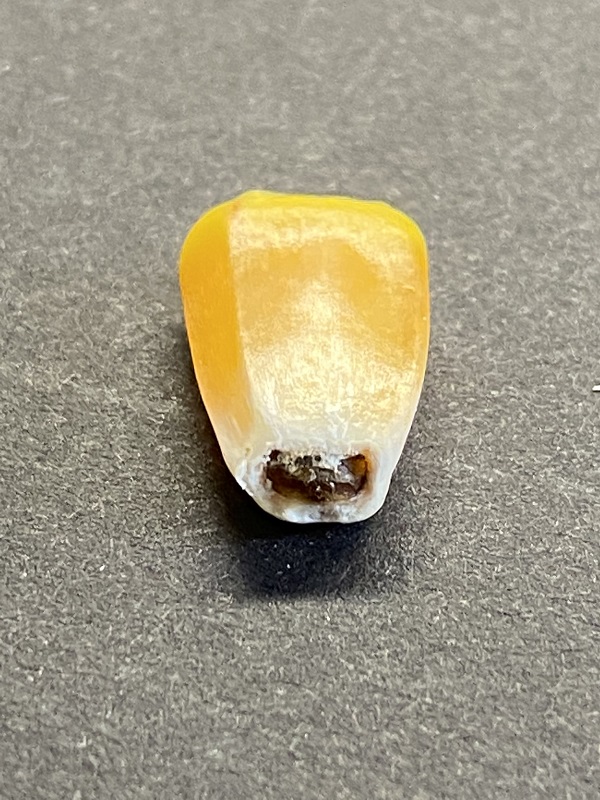
There have been a select few corn fields harvested so far this season. The moisture is, of course, still quite high in the high 20s and low 30s. Some fields are still just reaching black layer; thankfully, heavy frosts have mostly held off to this point.
The DON survey is currently underway. Thanks to all those who retrieved samples last week and provided their fields for sampling. Analysis is currently occurring, and we hope to see the final report in the coming week. The results of the survey will indicate what the DON levels of the corn were for the first week of October. Under these damp and cool weather conditions, the DON toxin can continue to increase in severity. Fields that looked clean two weeks ago are now showing white mycelium in the ear tips. Re-scout your fields to maintain an understanding of the potential risk.
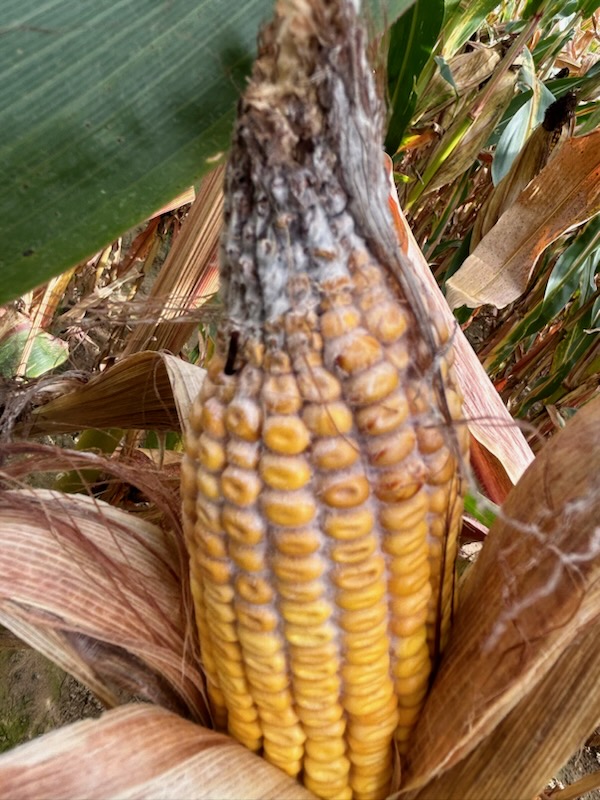
up in fields
Tar spot is still moving across the province and has been found in 10 counties. At this point of the year, any new occurrences of the disease will not impact yield when the crop is close to maturity. Understanding the spread of infection can help guide management decisions for next year, as we know the spores will be present from past crop residues. The earlier infected counties have seen their corn crop die early this year. Check tar spot affected fields for lower test weight, dryer grain, lower yield, and poor stalk and plan for an earlier harvest.
Soybeans
Soybean harvest has been stop-and-go in most regions since this past Thursday when rains arrived. However, soybean harvest has progressed incredibly rapidly, with 50 to 80 percent complete, with good yields reported.
Soybean harvest has also commenced in the far northwestern region of the province, with hopes that snow will not impede the harvest too much.
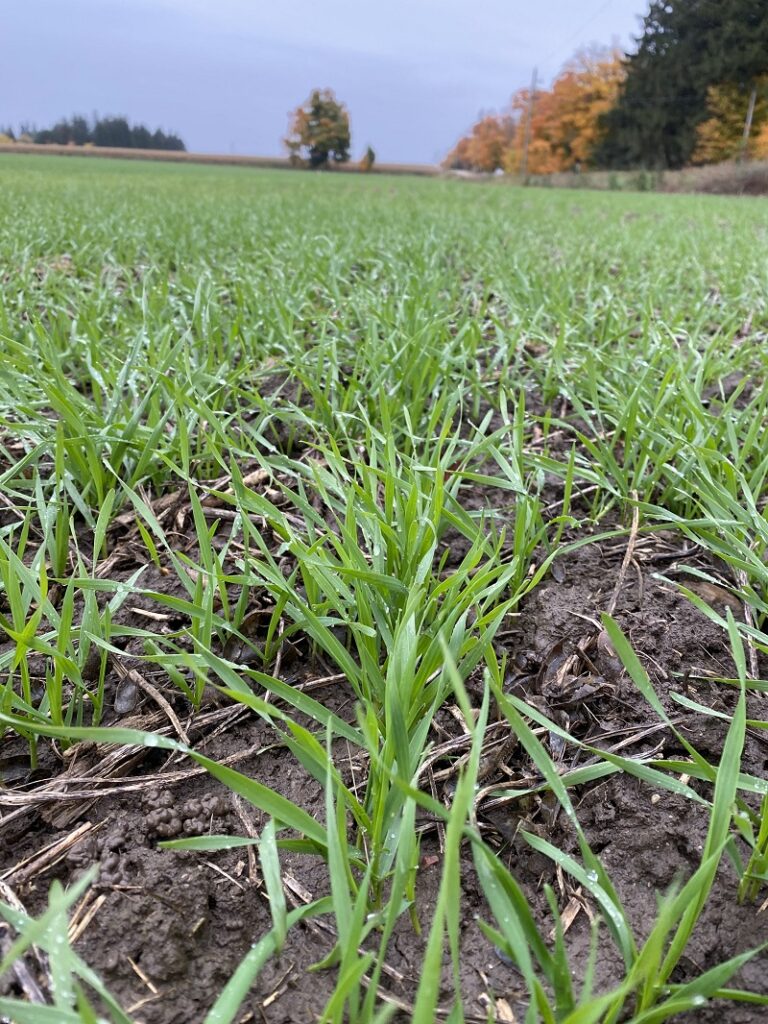
Cereals
Some winter wheat has emerged! The warm weather experienced at the start of the month has really helped the early planted fields.
Winter wheat continues to be planted, although most areas have edged out of the optimum wheat planting dates, except for the deeper parts of southwestern Ontario. You can find the optimum winter wheat planting dates in Ontario online.
For areas that have passed the optimum wheat planting window, please see the Agricorp Planting Deadlines for fall-seeded crops.
October 5, 2023
As Thanksgiving approaches, there is much to be thankful for — a bountiful harvest, above-seasonal temperatures, and open days for ideal harvest conditions. Corn has black layered or will be close to doing so in the next week. Soybean harvest is in full swing, with winter wheat going in the ground right behind soybeans. Have a safe and happy Thanksgiving.
Corn
Some fields have reached physiological maturity, also known as black layer (R6), with a few fields harvested for the early corn market. The majority of the corn acres are still in the late R5 stage, with a milk line around 75 percent. With no hard/killing frosts yet, there should be a nice finish to a healthy corn crop. Corn fields impacted by diseases like tar spot or northern corn leaf blight are dying or are dead already. These fields will have missed the nice finish and will need to be monitored.
The corn crop is considered mature when the black layer can be found on the tip of the kernel. To check, peel back the tip of the kernel where it is attached to the cob. The black layer acts like a one-way valve that shuts off moisture and nutrient flow into the kernel. Once formed, sugar will no longer be transferred to the kernel, and there will be no more dry matter accumulation. If the plants died prematurely from frost or disease, and the grain didn’t form a black layer, the grain will be lighter, wetter, and harder to harvest as the kernel tends to break off the cob, creating more fines.
When black layer occurs, it can be expected that the grain will be roughly 32 per cent moisture. Grain drydown will be the next phase over the coming weeks. Warm, dry weather can bring grain moisture down rapidly, but cooler weather with average rain will slow the drying process as humidity in the air is higher. Average fall conditions in October and November can see grain moisture decrease one per cent in roughly three days; or over 30 days, 32 per cent corn could be 22 per cent. Let’s hope that this nice open weather keeps up.
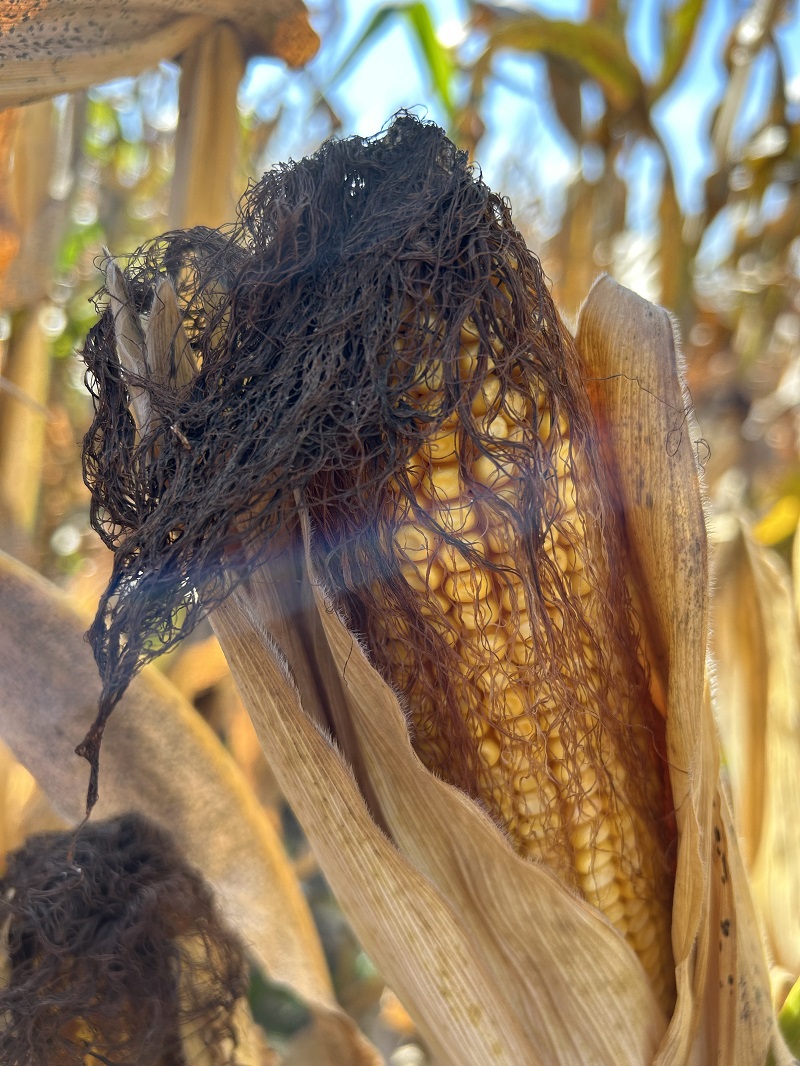
Corn hybrids differ in maturity from when they pollinate to when they reach black layer and how they dry down in the fall. Tight husk or open husk hybrids will dry differently. Looking at a test plot with different hybrids will give a better sense of what can be expected at harvest. For example, if the earliest flowering hybrid turns out to be the wettest in the plot, it may have a longer grain fill period (flowering to black layer) or tight husks that do not allow the kernels to shed moisture. These are all good things to assess rather than assume the early flowering hybrid is the driest, which it may not be.
In some cases, hybrids that have tighter husks are at a higher risk of disease development. Learn more about Gibberella ear rot and the potential for DON.
Soybeans

Most of the province is harvesting soybeans, roughly 50 percent complete. Ideal harvest moisture is 13 percent moisture; however, with this warm weather, soybeans will be drying down very quickly. If soybeans get too dry, they can start to split, and overall, the cheque received for grain weight will be less.
As harvest is ongoing, look for Palmer amaranth in fields and field edges. A plant was discovered earlier this season in Wellington County. This new to Ontario weed poses a significant challenge to grain production. Learn more about Palmer amaranth in this recently published Grain Farmers of Ontario Fact Sheet.
Cereals
Spring cereal harvest is still ongoing in areas with very good yields being reported.
Winter wheat planting is full steam ahead. Remember the winter wheat optimum planting date map. It takes approximately 80 Growing Degree Days (GDDs) for winter wheat to germinate and another 50 GDDs for it to emerge for 1 inch of seeding depth. Planting in the ideal window will allow for optimum conditions and growth for the wheat crop before winter sets in. If planting behind the optimum window, increasing the seeding rate by 200,000 seeds/acre per week to a max of 2.2 million seeds/acre is recommended to offset the delayed planting.
Joanna Follings, Cereals Specialist with the Ontario Ministry of Agriculture, Food and Rural Affairs, joined Laura Ferrier and Marty Vermey for a GrainTALK webinar to share her thoughts on planting date, fall outlook, planting conditions, phosphorus response, weed control, the Great Lakes YEN, and more. If you require CEU credits, the information to apply for them can be found within the webinar.
September 28, 2023
The soybean harvest has begun! Corn is moving towards black layer, with some corn with a milk line at 75 per cent. It is still a great time to scout the corn crop – watch for Gibberella ear rot, tar spot, and more. As wheat planting approaches, get up-to-date information about how to grow the yield potential in winter wheat.
Corn
The corn crop is trying hard to move the milk line toward black layer. The last number of days have provided a welcome weather pattern of sunny days with warmer temperatures, which will certainly help. Some fields are at roughly 75 percent milk line.
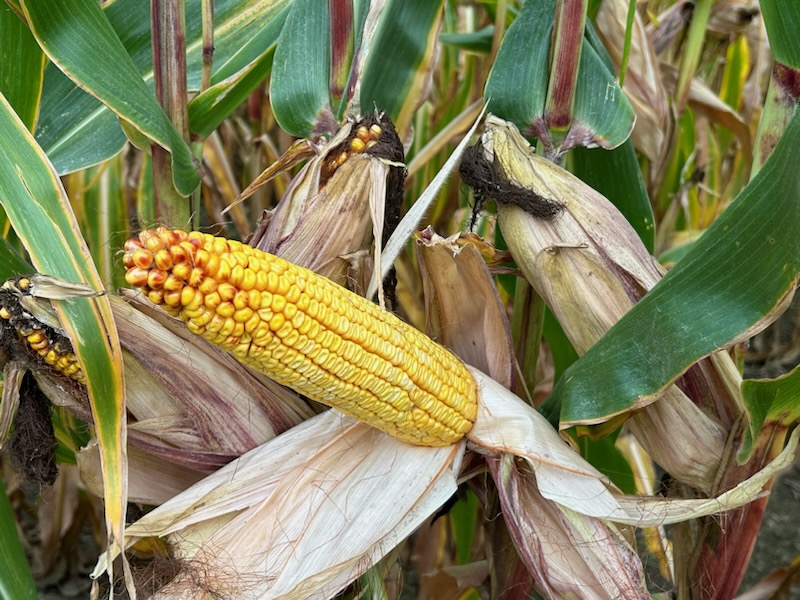
Frosts have been reported in higher elevation areas/more northern regions, and with that, the plants have started to shut down. The frosts have still been light (thankfully) but still impact the top leaves on the plant. After frost, the plants will be limited to any more sugar production, and the plants will need to rely on translocating the current sugars from the leaves and stalk to help finish the kernel starch pack. It can be expected that the lack of sugar in the stalk will weaken the stalk’s strength as the fall progresses. Keeping an eye on stalk deterioration will be important as certain fields are chosen to harvest first, and others are left until later.
The frosted corn will also have a fast moisture dry down in the whole plant. In turn, with dry weather conditions, good grain drying will also occur as no moisture will be taken up by the plant as it shuts down. However, if the grain did/does not reach black layer before a hard frost, that is a whole other topic. Read past week’s updates for more information.
Fields should be scouted for Western bean cutworm (WBC) injury and ear rot. If rot or injury is found, those fields should be prioritized for harvest, as the standability of the field will be lower along with increased disease incidence from injury and rot. Pictures of what to look for at this time of the year, along with more information, can be found here.
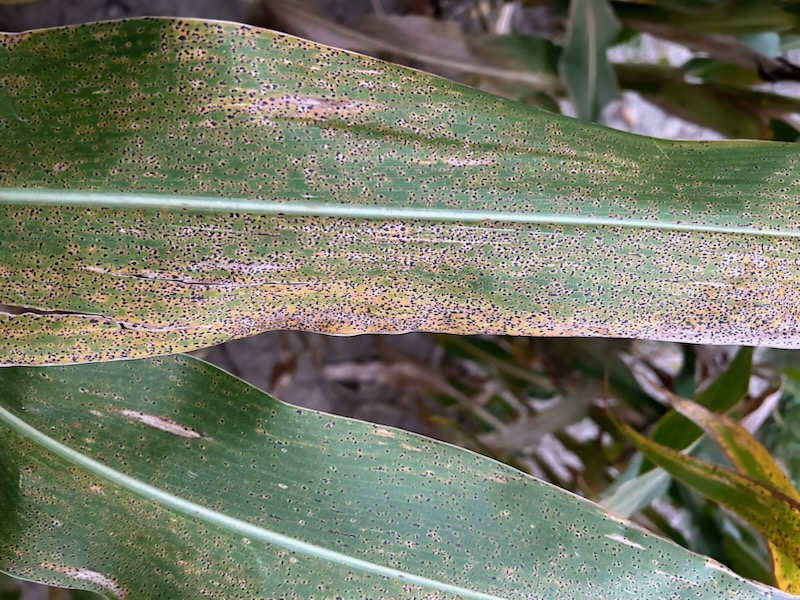
As with WBC, now is a great time to be on the lookout for goosenecked corn caused by corn rootworm. More info on this pest can be found here.
Tar spot has now been identified in nine counties. The new counties added to the list this past week are Oxford, Waterloo, Hamilton, and Brant.
As highlighted in last week’s field observations, DON in corn is a concern this year for some regions. Learn more about DON and how to manage it at harvest in the Grain Farmers of Ontario fact sheet.
Although not represented by Grain Farmers of Ontario, the corn silage crop harvest has begun this past week. With the warmer weather, there might be a push to get silage off before it dries down too much with the pleasant weather conditions being experienced.
Soybeans
Harvest has begun in earnest in areas that have soybeans mature enough. Yields so far have been reported at average to slightly above average, with moistures in the high to mid-teens, but there are still many more soybean acres to come off.
Have a safe harvest, take breaks when needed, and when the world turns upside down and things get to be too much, there are a number of resources to connect with someone for help.
Cereals
This week, Joanna Follings, cereals specialist with the Ontario Ministry of Agriculture, Food and Rural Affairs, joined Laura Ferrier and Marty Vermey to share her thoughts on planting date, fall outlook, planting conditions, phosphorus response, weed control, the Great Lakes YEN and more. Watch the Grain Farmers of Ontario GrainTALK Webinar here. If you require CEU credits, the info to apply for them can be found within the webinar.























